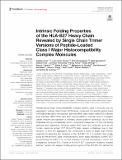Files in this item
Intrinsic folding properties of the HLA-B27 heavy chain revealed by single chain trimer versions of peptide-loaded class I Major Histocompatibility Complex molecules
Item metadata
| dc.contributor.author | Lenart, Izabela | |
| dc.contributor.author | Truong, Linh-Huyen | |
| dc.contributor.author | Nguyen, Dinh Dung | |
| dc.contributor.author | Rasiukienė, Olga | |
| dc.contributor.author | Tsao, Edward | |
| dc.contributor.author | Armstrong, Jonathan | |
| dc.contributor.author | Kumar, Pankaj | |
| dc.contributor.author | McHugh, Kirsty | |
| dc.contributor.author | Pereira, Branca I. | |
| dc.contributor.author | Maan, Balraj S. | |
| dc.contributor.author | Garstka, Malgorzata A. | |
| dc.contributor.author | Bowness, Paul | |
| dc.contributor.author | Blake, Neil | |
| dc.contributor.author | Powis, Simon J. | |
| dc.contributor.author | Gould, Keith | |
| dc.contributor.author | Nesbeth, Darren | |
| dc.contributor.author | Antoniou, Antony N. | |
| dc.date.accessioned | 2022-08-11T12:30:13Z | |
| dc.date.available | 2022-08-11T12:30:13Z | |
| dc.date.issued | 2022-07-25 | |
| dc.identifier | 280830330 | |
| dc.identifier | 427b87b2-40cb-4d27-9a1f-a61076f2e897 | |
| dc.identifier | 85136340663 | |
| dc.identifier | 000838118100001 | |
| dc.identifier.citation | Lenart , I , Truong , L-H , Nguyen , D D , Rasiukienė , O , Tsao , E , Armstrong , J , Kumar , P , McHugh , K , Pereira , B I , Maan , B S , Garstka , M A , Bowness , P , Blake , N , Powis , S J , Gould , K , Nesbeth , D & Antoniou , A N 2022 , ' Intrinsic folding properties of the HLA-B27 heavy chain revealed by single chain trimer versions of peptide-loaded class I Major Histocompatibility Complex molecules ' , Frontiers in Immunology , vol. 13 , 902135 . https://doi.org/10.3389/fimmu.2022.902135 | en |
| dc.identifier.issn | 1664-3224 | |
| dc.identifier.other | Jisc: 513284 | |
| dc.identifier.other | ORCID: /0000-0003-4218-2984/work/117211346 | |
| dc.identifier.uri | https://hdl.handle.net/10023/25825 | |
| dc.description | IL was supported by Versus Arthritis studentship (17868), AA was supported by an Versus Arthritis Fellowship (15293). PK was supported by Breast Cancer Now UK (2018JulPR1086). | en |
| dc.description.abstract | Peptide-loaded Major Histocompatibility Complex (pMHC) class I molecules can be expressed in a single chain trimeric (SCT) format, composed of a specific peptide fused to the light chain beta-2 microglobulin (β2m) and MHC class I heavy chain (HC) by flexible linker peptides. pMHC SCTs have been used as effective molecular tools to investigate cellular immunity and represent a promising vaccine platform technology, due to their intracellular folding and assembly which is apparently independent of host cell folding pathways and chaperones. However, certain MHC class I HC molecules, such as the Human Leukocyte Antigen B27 (HLA-B27) allele, present a challenge due to their tendency to form HC aggregates. We constructed a series of single chain trimeric molecules to determine the behaviour of the HLA-B27 HC in a scenario that usually allows for efficient MHC class I molecule folding. When stably expressed, a pMHC SCT incorporating HLA-B27 HC formed chaperone-bound homodimers within the endoplasmic reticulum (ER). A series of HLA-B27 SCT substitution mutations revealed that the F pocket and antigen binding groove regions of the HLA-B27 HC defined the folding and dimerisation of the single chain complex, independently of the peptide sequence. Furthermore, pMHC SCTs can demonstrate variability in their association with the intracellular antigen processing machinery. | |
| dc.format.extent | 3790460 | |
| dc.language.iso | eng | |
| dc.relation.ispartof | Frontiers in Immunology | en |
| dc.subject | HLA-B27 | en |
| dc.subject | Ankylosying spondylitis | en |
| dc.subject | MHC class I misfolding | en |
| dc.subject | Single chain trimers | en |
| dc.subject | F pocket | en |
| dc.subject | HLA-B27 alleles | en |
| dc.subject | QR180 Immunology | en |
| dc.subject | DAS | en |
| dc.subject | SDG 3 - Good Health and Well-being | en |
| dc.subject.lcc | QR180 | en |
| dc.title | Intrinsic folding properties of the HLA-B27 heavy chain revealed by single chain trimer versions of peptide-loaded class I Major Histocompatibility Complex molecules | en |
| dc.type | Journal article | en |
| dc.contributor.institution | University of St Andrews. School of Medicine | en |
| dc.contributor.institution | University of St Andrews. Centre for Biophotonics | en |
| dc.contributor.institution | University of St Andrews. Institute of Behavioural and Neural Sciences | en |
| dc.contributor.institution | University of St Andrews. Biomedical Sciences Research Complex | en |
| dc.contributor.institution | University of St Andrews. St Andrews Bioinformatics Unit | en |
| dc.contributor.institution | University of St Andrews. Cellular Medicine Division | en |
| dc.identifier.doi | https://doi.org/10.3389/fimmu.2022.902135 | |
| dc.description.status | Peer reviewed | en |
This item appears in the following Collection(s)
Items in the St Andrews Research Repository are protected by copyright, with all rights reserved, unless otherwise indicated.

